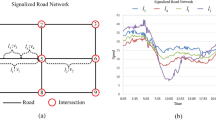Abstract
Constant traffic congestion consumes enormous amounts of energy and causes vastly increased journey times. Therefore, real-time traffic information is of great importance to the public because such information is invaluable to more efficient traffic control and travel planning. To obtain such information in metropolises like Shanghai, however, is very challenging due to the extraordinarily large scale and complexity of the underlying road network. In this paper, we propose a novel traffic estimation scheme utilizing surveillance cameras pervasively deployed in cities. With only a limited number of roads with cameras, we adopt a measurementbased traffic matrix (TM) estimation method to infer the traffic conditions on those roads with no cameras. Extensively trace-driven simulations as well as field study results show that our scheme can achieve high accuracy with a very limited number of measurements. The accuracy of our measurement-based algorithm outperforms the traditional speed-based and model-based approaches by up to 50%.
Similar content being viewed by others
Explore related subjects
Discover the latest articles and news from researchers in related subjects, suggested using machine learning.References
Yang X, Liu L, Vaidya N, Zhao F. A vehicle-to-vehicle communication protocol for cooperative collision warning. In: Proccedings of the First Annual International Conference on Mobile and Ubiquitous Systems: Networking and Services. 2004, 114–123
Lin W, Daganzo C. A simple detection scheme for delay-inducing freeway incidents. Transportation Research Part A: Policy and Practice, 1997, 31(2): 141–155
Coifman B. Identifying the onset of congestion rapidly with existing traffic detectors. Transportation Research Part A: Policy and Practice, 2003, 37(3): 277–291
Li Z, Zhu Y, Zhu H, Li M. Compressive sensing approach to urban traffic sensing. In: Proceedings of the 31st International Conference on Distributed Computing Systems. 2011, 889–898
Zhu H, Zhu Y, Li M, Ni L. Seer: metropolitan-scale traffic perception based on lossy sensory data. In: Proceedings of IEEE INFOCOM 2009. 2009, 217–225
Yoon J, Noble B, Liu M. Surface street traffic estimation. In: Proceedings of the 5th International Conference on Mobile Systems, Applications and Services. 2007, 220–232
Bhattacharjee D, Sinha K, Krogmeier J. Modeling the effects of traveler information on freeway origin-destination demand prediction. Transportation Research Part C: Emerging Technologies, 2001, 9(6): 381–398
Medina A, Taft N, Salamatian K, Bhattacharyya S, Diot C. Traffic matrix estimation: existing techniques and new directions. In: Proceedings of ACM SIGCOMM Computer Communication Review. 2002, 161–174
Chang G L, Wu J. Recursive estimation of time-varying origindestination flows from traffic counts in freeway corridors. Transportation Research Part B: Methodological, 1994, 28(2): 141–160
Li M, Liu H, Jiang C, Tong W, Zhou A, Zhu Y, Jiang S, Rao R, Cao J, Deng Q, Qian Q, Jin W. Shanghai grid in action: the first stage projects towards digital city and city grid. Grid and Cooperative Computing, 2004, 616–623
van der Zijpp N. Dynamic origin-destination matrix estimation from traffic counts and automated vehicle identification data. Transportation Research Record: Journal of the Transportation Research Board, 1997, 1607: 87–94
Zhang Y, Roughan M, Willinger W, Qiu L. Spatio-temporal compressive sensing and internet traffic matrices. ACM SIGCOMM Computer Communication Review, 2009, 39(4): 267–278
Cremer M, Keller H. A new class of dynamic methods for the identification of origin-destination flows. Transportation Research Part B: Methodological, 1987, 21(2): 117–132
Nihan N, Davis G. Recursive estimation of origin-destination matrices from input/output counts. Transportation Research Part B: Methodological, 1987, 21(2): 149–163
McNally M, Marca J, Rindty C, Koos A. Tracer: in-vehicle, gpsbased, wireless technology for traffic surveillance and management. Technical Report UCB-ITS-PRR-2003-23, California Patneres for Advanced Transit and Highways(PATH). 2003
Ygnace J, Drane C, Yim Y, Lacvivier R. Travel time estimation on the San Francisco bay area network using cellular phones as probes. Technical Report UCB-ITS-PWB-2000-18, California Partners for Advanced Transit and Highways (PATH). 2000
Liu S, Liu Y, Ni L, Fan J, Li M. Towards mobility-based clustering. In: Proceedings of the 16th ACM SIGKDD International Conference on Knowledge Discovery and Data Mining. 2010, 919–928
Smart city research group, hkust. http//www.cse.ust.hk/scrg
Cho Y. Estimating velocity fields on a freeway from low-resolution videos. IEEE Transactions on Intelligent Transportation Systems, 2007, 7(4): 463–469
Zhu H, Li M, Fu L, Xue G, Zhu Y, Ni L. Impact of traffic influxes: revealing exponential inter-contact time in urban VANETs. IEEE Transactions on Parallel and Distributed Systems, 2011, 22(8): 1258–1266
Author information
Authors and Affiliations
Corresponding author
Additional information
Guangtao Xue received his PhD in Computer Science from Shanghai Jiao Tong University in 2004. He is an associate professor in the Department of Computer Science and Engineering at the Shanghai Jiao Tong University. His research interests include mobile networks, social networks, sensor networks, vehicular networks, and distributed computing. He is a member of the IEEE Computer Society and the Communication Society.
Ke Zhang received BS degree from Computer Science and Technology department of Finance and Economics of Jiangxi University in 2007. He received his MS degree in Computer Science from Shanghai Jiao Tong University in 2012. He is now a Browser-OS kernel developer in Baidu Corporation.
Qi He received his BS degree in Computer Science from Zhejiang University in 2009. He is currently a Master student at Shanghai Jiao Tong University under the supervision of Prof. Guangtao Xue. His research interests include data mining, social networking, delaytolerant networking, and cloud computing. Currently, his research mainly focuses on the improvement of wireless access point load balancing situation and data mining from user based 3G mobile networks.
Hongzi Zhu received his PhD in Computer Science from Shanghai Jiao Tong University in 2009. He is an assistant professor in the Department of Computer Science and Engineering at Shanghai Jiao Tong University. His research interests include mobile networks, vehicular networks, and network security. He is a member of the IEEE Computer Society and Communication Society.
Rights and permissions
About this article
Cite this article
Xue, G., Zhang, K., He, Q. et al. Real-time urban traffic information estimation with a limited number of surveillance cameras. Front. Comput. Sci. 6, 547–559 (2012). https://doi.org/10.1007/s11704-012-2051-9
Received:
Accepted:
Published:
Issue Date:
DOI: https://doi.org/10.1007/s11704-012-2051-9




